#first lucky buck of one thousand kingyotoyaki (oc)
Text


Flood stuff
571 notes
·
View notes
Text
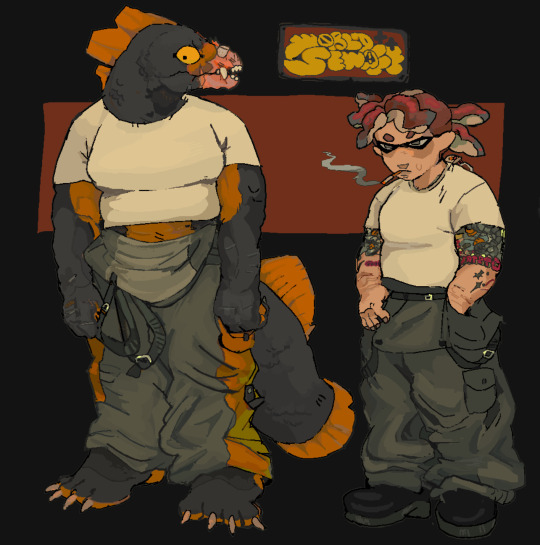
#homerun au#my art#splatoon oc#Fido (oc)#First Lucky Buck of One Thousand Kingyotoyaki (oc)#working on a short comic. have these two in thr mean time#transfem salmon call that transhen#cause s#girl salmons are called hens#nvm
519 notes
·
View notes
Note
What is Fido and First Lucky Buck of One Thousand Kingyotoyaki's relationship like? (+ How do salmonid names work? In your big lore dump you talked about clan/family names, but is there something other structure they follow?)

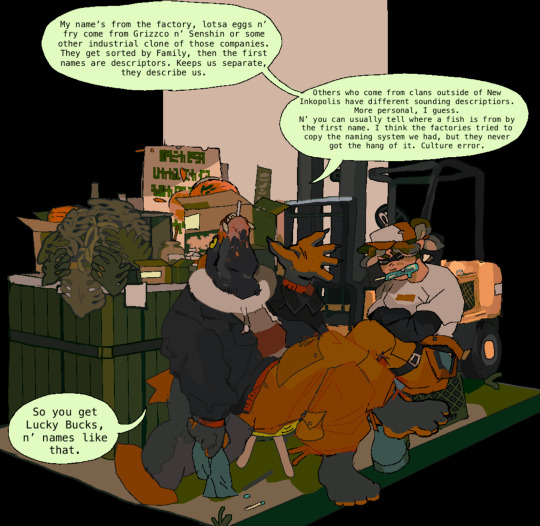

249 notes
·
View notes
Note
what's the home run au?? pretty please infodump!! /genpos /nf

The HOMERUN au is what I want to call a Salmonid and Inkling swap au, but eventually became so convoluted it’s now it’s own separate thing.
I’m glad this ask exists because I will be using it as a pseudo pinned… until I get that… figured out… ⛩️ thank you! I’ll be splitting the main ideas into parts, (and chances are any unanswered questions will be answered later! I want to explore this au in little lore tidbits, so please be patient with me! But don’t be afraid to ask!)
Idol / Agent lore will be explained in mini comics and posts… :] but as for what the Homerun au actually is…?
I’ll explain everything under the cut!
THE GREAT TURF WAR:
During the Great Turf War— inklings and octolings were at a horrible stand still, resources and morale is low due to the two warring species exhausting themselves. The waterline rises high (WAY higher then canon) wiping out the lands they’re fighting for and reducing the habitable lands into waterlogged territories that are too dangerous and flood-prone for either species to survive… the war ended with Salmonids on the rise, dominating the lands, and nearly wiping out both species thanks to the ocean and the brute strength and resources they had.
Because of this inkling territory is very small— but still succeeded in claiming land, unlike the Octarian, which were forced to retreat to the wastelands— the wastelands are devoid of life, but worse, flooded and horribly weathered.
Relationships between the warring species goes as this: Politically, all of the species are enemies, but at this current state, have no real reasons to continue fighting.
Salmonoids are trying to “mend the relations between Cephalopods and Salmonids”— at least that’s what they’re saying. They make efforts such as propaganda pieces, but their biology(see “anatomy” column) Is far too different from cephalopods to properly live together. They mostly push this effort towards Inklings— half because they are the species that utterly despises them, and the other half as a power play. A few Salmonid Company’s that control the local politics have a few ideas they want to use to control inklings, but it’s no use if they’re not allies.
Octarians still see inklings as the species that drove them out, despite salmonids being the unlikely winner of the war, Inklings are the ones that claimed the only slightly habitable lands, so they are the adversary.
Octarians are still an ally to the salmonids, their industrial mega cities are often seen as “barbaric” or “frightening” to most species, but the Octarian see them as war-strong allies who they desperately need to learn off of. Octarian culture has vastly evolved to accommodate Salmonids— this has changed most Salmonid’s(within the public) understanding of inkling/octoling biology for the better. Having survived off their trade / resources, every Octarian issue becomes a Salmonid issue, and vice versa, these two groups are closely intertwined.
Inklings are enemies with the Salmonids, but due to their loss in the war they were forced to truce— Inklings are the only species that do salmon runs, so they see Salmons at their most aggressive, and in turn are taught to view them as monsters, despite the species affinity towards politics, business, and other relations they’ve made public— they only see them as language-less inkling-murdering monsters. Because of their hatred of salmonids— they yearn to rekindle the relationship with Octarians.

It’s a real “be my ally” love triangle. But truly, Octarians and Salmonids are BUDDIES!
THE MAP
Inklings are doing better, they still construct Inkopolis in this au. Inkopolis is prone to flooding, but it’s still plenty safer and operates much like it does in canon (with the same stores and such!). The city is now equipped with many functions that keep it’s citizens safe from flooding. Flooding is less common in the plaza as opposed to the outskirts of the city. Inkopolis is a staple location, proof of survival and glory, the place every kid said they wanted to move to when they got older.
The Octo-Canyon + Domes still exist here, but the surrounding area is nearly all water, so resources are scarce and its difficult for them to survive on their own. They thrive on trade, and what can only be described as “for-hire agent work” for salmonoids and other wasteland neighboring species. Their technology was forced to rapidly advance to accommodate for this.
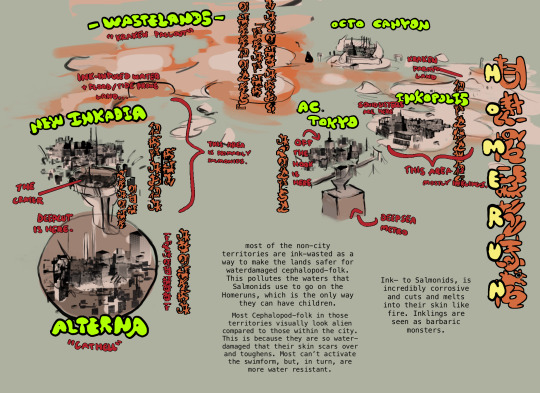
The area right to Inkopolis, where Calimari County would lie, are sandy (sort of beach-swamp esque) farm lands. The towns are rural distant areas, perpetually flooded, sort of resembling low tidepools, it’s pretty gorgeous lands . They primarily farm seaweed here, as well as cultivating other sea animals and rice grain.
The area above New Inkadia— in the Wastelands— is similar, farm lands and small villages, but to note: more Salmonids are here, and the inklings here speak Salsegal (the language salmonids speak) and here Salmonids and Cephalopods engage in this reverse salmon run.
The Wasteland inklings cultivate and raise Zapfish, most are young and unable to power full cities, and so Cephalopods in this zone have (as a result of water damage affecting HOW they retain ink) developed a new type of ink that is able to act as an electrical current— these types of inklings/octolings are known as KRAKENS, and Salmonids occasionally enter these areas and capture this electric ink technology since it’s on their turf, and they can’t use their eggs out of respect, Zapfish are in low supply, and in turn, Inklings collect power eggs.
AC TOKYO is a city built on the idea of mending the relationships and creating a society where all species can thrive! And oddly enough, the city and decor is described as historic… due to all of the designs looking very… human. The reason for this is unknown. (Wink.) (DEEPSEA METRO rests underneath it.)
NEW INKADIA is where splatoon 3’s locations lie! Though under a different name, and a very different appearance, and ALTERNA is a secret project that has created an entirely new society that consists of both Cephalopods and Salmonids… at the expense of changing them.
Alterna is where DEEPCUT appear.
ANATOMY
How salmonids and inklings function is plenty different from canon
Inkling’s skin is incredibly paper-thin fragile, but extremely reliable, it is made up of trillions of individual parts that collapse into a thin membrane that essentially splits all of the insides into even tinier parts when coming into contact with a certain chemical signal that triggers the “transformation reaction”, allowing their skin to collapse into Ink Puddles, and as a result allowing it to reform into the Swim Form. So essentially, when Inklings are in the “puddle form”, they are a super thin nearly invisible sac carrying all of their super small broken apart organs, and reforming is just these broken apart cells very quickly attaching back together to either shape into Kid or Squid.
When a cephalopod gets “splatted”— all that’s happening is that there’s either too much stress, or too many injuries, or there’s a drastic shift in the amount of ink the subject is currently carrying, causing them to Self Destruct, as inklings are safer when the cells are broken apart, it’s harder to damage larger parts of the inkling IF they are broken into tiny parts that cant be broken apart any further.
“RESPAWNERS” aren’t actually “a place for the ghosts of inklings to land to revive”— this is a myth, and plenty easier to explain.
Respawners are attached onto the ground in inky turf grounds, and they cycle through ink at an extremely fast rate. Most turf battles have a very small layer of water or ink on the ground to allow respawner to filter ink— in doing this, the respawner are drinking in a shit tone of ink in order to suck up inkling puddles that carry near invisible flesh sacs thanks to Inkling’s weird skin membrane. And in the respawner, they’re refreshed with new ink and injected with a chemical that shakes them awake, quickly waking up a splatted inkling inside the respawner.
During Salmon Runs, the sight of Inklings who are missing limbs on the battlefield returning the next day to attend a shift with no visible injuries isn’t uncommon. As long as the cells still exist within the membrane, they can be rapidly rebuilt and regenerate.
But, despite all of this, Inkling skin is incredibly weak to water, this membrane that can carry collapsed organs, severed limbs, and gives the signal that allows inklings to transform— can melt and collapse and can permanently damage if coming into contact with too much water. Water against this skin-membrane is similar to water on a tissue, melting into it, and splatting the inkling— but because there is now a tear in the membrane— it affects how the inkling is able to heal, how quickly the inkling can recover, how much ink the inkling can now retain, or if it’s possible to transform after the injury. Membrane Water-Damage scars can vary, but they are all regarded as dangerous if left untreated too long. Since small holes can be treated and taught to heal over, but left in water, can cause these holes to grow too large for the membrane to function as intended.
In fact, even overly HUMID environments can wear on inkling skin overtime; which is a problem for cephalopods and salmonid relations.
Salmonids have gills, but are amphibious, and in the adult (not spawning, spawning Salmons have very different anatomy, I will go into salmonid life cycles below) stage of their growth, they require air to thrive. Hence, needing land, but because they have gills, they require humid environments or close by water in order to keep the gills moist. Or else they could dehydrate and suffocate.
TLDR: inklings+octolings need dry environments so they don’t die from overexposure to humidity/water, Salmonids need wet humid environments so they don’t suffocate to the lack of water.
SALMON RUNS, and the LIFE CYCLE:
During salmon runs, you collect eggs, and in the warehouse, fertile eggs are seperated from infertile eggs, and are shipped back to Salmonid cities.
In salmonid cities, the eggs are sorted, genetically tested, and are given a name— the reason why salmonids have such long names is because the eggs are named by the title of the clans of their origin, and the families then extend the titles via new names or traits.
Having children isn’t a decision that can be made on a whim, since it requires traveling to a salmon run grounds in a race to these lands that allow both parents to officially breed in what’s known as a “HOMERUN,” but unlike IRL salmon, the need to return home is NOT a requirement or a hormonal change, but rather a decision, and the transformation into spawning-forms is a result of the journey.
Most parents have hundreds of eggs, and hundreds of children, but most of the time— in salmonid culture, only those who are considered “high status” are selected to “bring glory to the clan name” and go on these homeruns, most common folk don’t.
Salmonids are in a way socially (a tad culturally) aromantic, in a way, since they don’t have any desire to find a special someone never sprung into existence, especially since relationships initially begin as a concept due to the act of having children, but to salmons, it is viewed as a business decision. So romance is nearly non existent. (Again, socially, not emotionally, but the concept is still very much foreign.)
All salmonids are orphans in some way or another due to the parents dying in the Homerun (it’s extremely rare for a parent to return, if they do, it’s most likely they won’t survive the transformation back into a non-spawning form— which is why those who do survive usually remain in homerun grounds.)
The offspring are given back to the clans of parents of the children, not as eggs, they leave them to develop and once they become “SMALL FRY” they are given to the families.
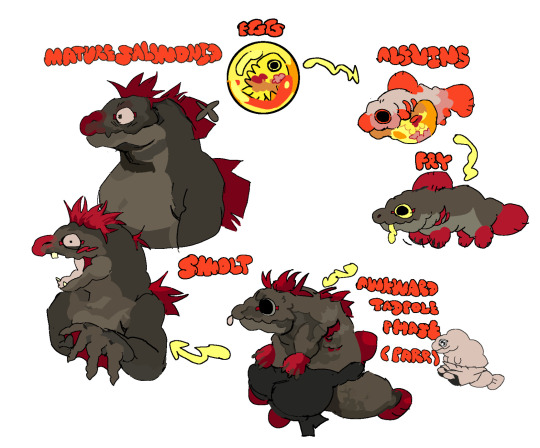
THE EGG- power eggs, power houses, even infertile eggs are still high wattage batteries.
ALEVINS- you will most likely never see these few, in the wild, they grow up in the water and feed off the power egg.
FRY- they begin to grow lungs and muscle, they start to come onto land and use their fins as hands, if only slightly. They still are stronger swimmers than they are walkers. This is the stage in which they begin to swim home, they aren’t very good learners due to this form expending all energy in strength in order to travel and survive.
AWKWARD TADPOLE PHASE! - their fins grow into hands, and they slowly learn to walk. You see this stage at around four or five years old. This is considered the most important time in thier lives, because as FRY, they were running on instinct more than anything, so this is the time when their brains truly start to develop. Their head fins sort of fray, splitting into a growing head fin and a dorsal fin.
SMOLT- The phase between Tadpole and Nearly fully fledged salmon, their hands begin to fully form, they have more canine teeth that begin to grow in as teenagers. Fingers are webbed! The dorsal fin grows in. Most teenagers are still a tad hunched, but otherwise have no issues standing upright.
MATURE SALMON- Dorsal fin is fully developed, and they stand without a hunch.
In order to have offspring, they HOMERUN, and doing this transforms them back into waterborne species to accommodate for the vast journey. Their arms turn into fins, this change is far too jarring and aggressive for the species to live long after this.
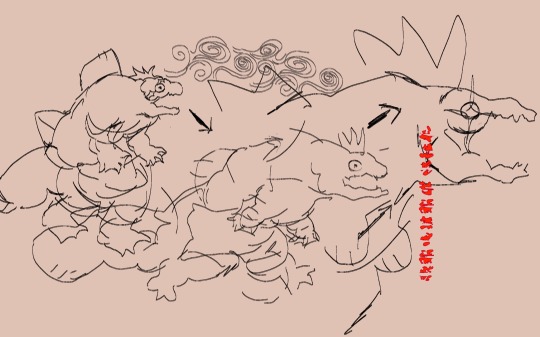
SALMON RUNS ONLY EXIST BECAUSE INKLINGS HAVE DISTURBED THE NATURAL PATH THAT SALMONIDS NEED TO TAKE IN ORDER TO HAVE OFFSPRING. They intend to enter the aggressive phase at the river, before reaching the end mid land, but because inklings occupy this land, they’re forced to remain in these aggressive stages.
The slaughter of the spawning season salmonids is not a part of the cycle that salmonids worship so thoroughly. But, Salmonids were designed to die during this phase, and they never grew to be revolted by this idea— but that is not the reason why.
A Grizzco partner company named SENSHINCORP. that specializes in Cephalopod/Salmonid Trade, Safety, and Relations has taken control of the public’s opinion of the neighboring species.
(it’s a persuasive warning shot that makes every species doubt the opinions they feel they should have. It’s the reason why new paths weren’t created for Homerun Salmonids, POWEREGGS are big buck business, and it’s best you don’t pry.)
Okay, final section:
GRIZZCO. (+SENSHINCORP.)
Grizzco functions the same, a company that thrives on exploiting desperate job hunting inklings, and exploiting a culture that relies on the glory of dying.
But, this time, Mr. Grizz remains in contact with Senshin Corp, a salmon operated company that thrives on the tension between salmonids and cephalopods.
Salmo-San owns Senshin Corp, he’s a friend. He only wishes the best.

184 notes
·
View notes
Note
WHO IS FIDO WHATS THEIR FAVOURITE FLAVOUR JUICE
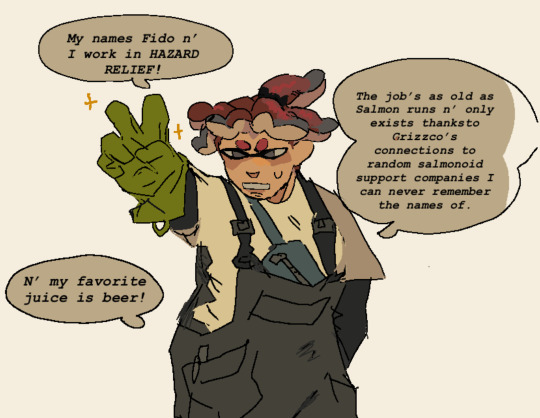
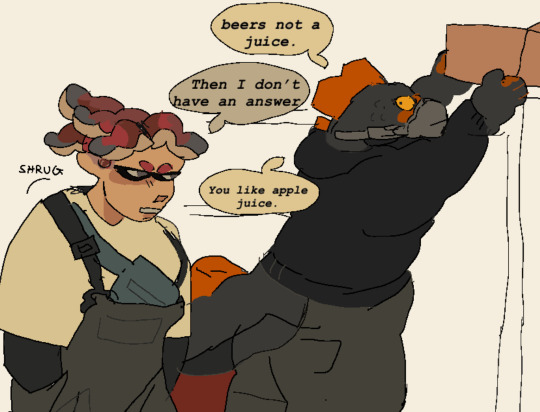
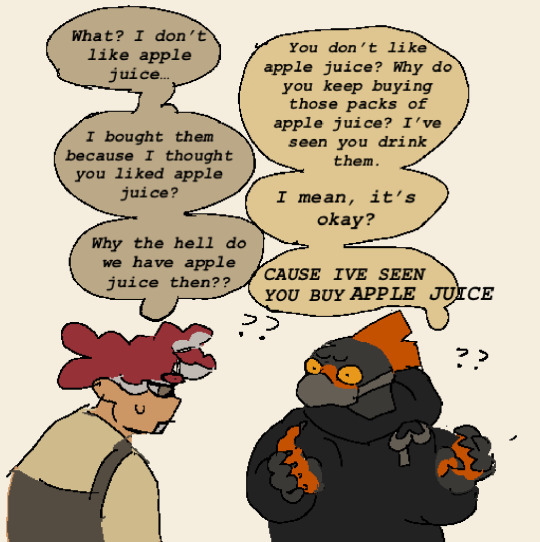
Maybe cider would count a tad more.
123 notes
·
View notes
Note
CAN YOU TELL ME ABOUT BUCK I LOVE LUCKY BUCK!!!!!!!!!!!!!!!!!!!!!! pronouns personality fun facts etc I love buck…
Kingyoto uses he/him pronouns, but is a girl.
^ to Salmonids, pronouns are indicative of statues and act more like honorifics. Due to Inklish not having terms in their language that properly suit this idea, the translation leaves “he/him” to most blue collar class working common folk, and “she/her” to running salmonids and Salmonids who are probably destined to Run later in life… Octarian language has many more gendered terms than Inklish, which simply has two — feminine and masculine, and the feminine term was given to running Salmonid’s as a result of terms such as “queen being” and “egg laying,” being used to describe King Salmonids in their original language: ‘Salsegal.’
Kingyoto is probably the only salmonid in Hazard Relief, Inkopolis isn’t a super diverse area, being primarily inklings, and he didn’t speak much if at all ANY Inklish. He could understand the language (to an extent), but has trouble mimicking the vocal notes used in the language.
Started working in Hazard Relief when he was 13, it was near a not-fully developed AC TOKYO, and it wasn’t under the name “Hazard Relief,” he would sift and pull Salmonid remains from up the river, where Salmonids die or get killed in the Homerun. Eventually Senshin Corp. got formed, and provided a more “elegant” approach to these jobs.
When more jobs in this position opened up— Kingyoto decided to move to Inkopolis solely because he’s a die hard Squid Sisters fan.
Kingyoto lives pretty far from the Grizzco office where he works, this is because most houses near Inkopolis don’t follow the housing standard in Salmonid communities (needing a certain humidity content, needing a certain type of bed, etc etc.)
Fido taught Kingyoto most of the Inklish he knows, Kingyoto’s job was initially heavy lifting since Inklings couldn’t go in the water, but he somehow managed to climb the ranks slightly.
Kingyoto is certified to manage a few heavy machines. Likes to make sure they’re in tip top condition.
Kingyoto has a shitty truck that he’s been driving before he was even legally allowed to. It has about 4 different radios inside of it because he keeps forgetting to get rid of the ones that break.
Likes to attend after work get togethers, but doesn’t drink. He’s subjected to way too many Drunk Comments (tm) at a time, tends to be very patient despite it.
He likes honey flavored foods and drinks, which seems to be a popular beverage in Salmonid cities (and tastes very different from Honey teas), it is NOT so popular in Inkopolis. He manages with honey - vanilla teas though.
#many inklings were a little threatened by Kingyoto when he was first hired… but salmonid immigrants who are willing#to fish remains out of a river for#a “decent’ wage#make incredibly reliable employees when you hand them dental care to go along with a hazardous work environment#asks#homerun au#salmonids#fido (oc)#first lucky buck of one thousand kingyotoyaki (oc)#this fish has boobs!! for god knows why!!! oh well.
25 notes
·
View notes